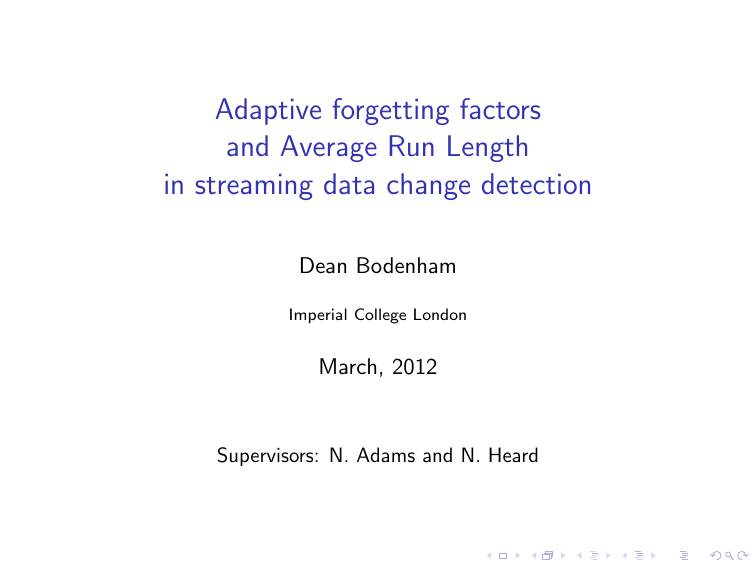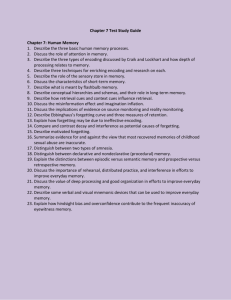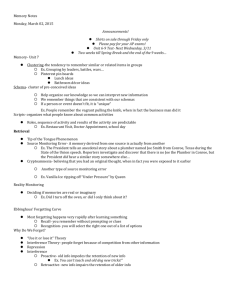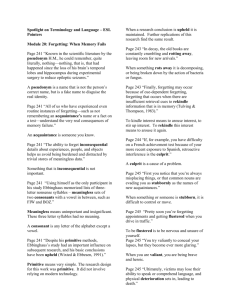Adaptive forgetting factors and Average Run Length in streaming data change detection
advertisement

Adaptive forgetting factors
and Average Run Length
in streaming data change detection
Dean Bodenham
Imperial College London
March, 2012
Supervisors: N. Adams and N. Heard
Overview
◮
Change Detection: Streaming Data
◮
Two Algorithms: CUSUM and EWMA
◮
Performance Measures: ARL0 and ARL1
◮
Forgetting Factors Mean
◮
Assuming Normality
◮
Adaptive Forgetting Factors
◮
Experiments and Results
◮
Related Aspects
◮
Future Work
Change Detection: Streaming Data
We define a data stream to be a sequence of random observations
x1 , x2 , . . . . We assume that these observations are:
◮
sequential
◮
unpredictable when and how they change
For convenience, we treat the observations as arriving at regularly
spaced intervals.
Goals:
◮
To detect changes in the data stream sequentially,
◮
Algorithm should restart and continue after a change
We are mainly interested in regime changes, such as
mean/variance change, e.g. N(0, 1) → N(2, 1)
Control Charts
−4
−2
0
mat
2
4
A control chart consists of points z1 , z2 , . . . representing a
statistic and control limits a, b, where a < b. When
◮ zk ∈ (a, b) ⇒ process is in-control
◮ zk 6∈ (a, b) ⇒ process is out-of-control
0
20
40
60
80
t
We call τ the changepoint of the data stream if
◮ zτ 6∈ (a, b), but
◮ zk ∈ (a, b) for all k < τ
100
Overview
◮
Change detection: Streaming Data
◮
Two algorithms: CUSUM and EWMA
◮
Performance Measures: ARL0 and ARL1
◮
Forgetting Factors Mean
◮
Assuming Normality
◮
Adaptive Forgetting Factors
◮
Experiments and results
◮
Related aspects
◮
Future Work
CUSUM (Page, 1954)
Parameters chosen: d, B
Observations: x1 , x2 . . . , with E[xk ] = µ and Var[xk ] = σ 2 .
To detect an increase in the mean, define:
Tk = xk − µ + dσ
⇒ E[Tk ] = dσ
Now define the CUSUM:
S0 = 0
Sk+1 = max{0, Sk + Tk+1 }
A change is detected when:
Sk > Bσ
EWMA (Roberts, 1959)
Parameters chosen: r , L, (L = 3, usually)
Observations: x1 , x2 . . . , as before.
To detect an increase in the mean, define:
z0 = µ
zk = rxk + (1 − r )zk−1 ,
k>0
It can be shown that the standard deviation of zk is
r
r σzk =
1 − (1 − r )2k σ
2−r
A change is detected when:
zk > µ + Lσzk
Review of CUSUM and EWMA
Although both CUSUM and EWMA are excellent sequential
change-detection algorithms, we would like an algorithm that:
◮
◮
does not require knowledge of the parameters of the
underlying distributions
does not require a “subjective” choice of free parameters
◮
◮
CUSUM needs (d, B), EWMA needs (r , L)
can operate well on a stream; does not require/learns new
parameters after a change
Overview
◮
Change Detection: Streaming Data
◮
Two Algorithms: CUSUM and EWMA
◮
Performance Measures: ARL0 and ARL1
◮
Forgetting Factors Mean
◮
Assuming Normality
◮
Adaptive Forgetting Factors
◮
Experiments and Results
◮
Related Aspects
◮
Future Work
Performance Measures: Average Run Length (ARL)
ARL0: average number of observations until a false alarm.
ARL1: average delay in detecting a changepoint.
We would like our algorithm to have:
◮
High ARL0
◮
Low ARL1
Overview
◮
Change Detection: Streaming Data
◮
Two Algorithms: CUSUM and EWMA
◮
Performance Measures: ARL0 and ARL1
◮
Forgetting Factor Mean
◮
Assuming Normality
◮
Adaptive Forgetting Factors
◮
Experiments and Results
◮
Related Aspects
◮
Future Work
Tracking the mean
Suppose we want to monitor a stream x1 , x2 , . . . , xN , . . . .
We could calculate the mean x̄N of the first N observations as
x̄N =
N
1 X
xk
N
(1)
k=1
Or, we could calculate it sequentially as
mk = mk−1 + xk ,
m0 = 0
(mass)
(2)
wk = wk−1 + 1,
mN
x̄N =
wN
w0 = 0
(weight)
(3)
(mean)
(4)
However, this formulation gives equal importance (weight) to
each observation.
Calculating the mean: Forgetting Factor
We introduce an exponential forgetting factor λ ∈ [0, 1], and
calculate the forgetting factor mean x̄N,λ
x̄N,λ =
1
wN,λ
where
wN,λ =
N
X
λN−k xk
(5)
k=1
N
X
λN−k
k=1
Example: N = 3 and λ = 0.9:
1
x̄3,λ = (0.9)2 x1 + (0.9)x2 + x3 ·
w3,λ
w3,λ = (0.9)2 + (0.9) + 1
(6)
Forgetting Factor Mean
In general:
x̄N,λ =
1
wN,λ
λN−1 x1 + λN−2 x2 + · · · + λ xN−1 + xN
The extreme cases of λ = 1 and λ = 0:
◮
when λ = 1, x̄N,λ = x̄N (unweighted mean, no forgetting)
◮
when λ = 0, x̄N,λ = xN (last observation, forgets everything)
The forgetting factor λ ∈ (0, 1):
◮
downweights early observations (x1 , x2 , . . . ), and therefore
◮
more weight on recent observations (. . . , xN−1 , xN )
Forgetting Factor Mean
We can also define x̄N,λ sequentially as:
mk,λ = λmk−1,λ + xk ,
m0,λ = 0
(mass)
wk,λ = λwk−1,λ + 1,
mN,λ
x̄N,λ =
wN,λ
w0,λ = 0
(weight)
(mean)
Compared to the unweighted mean from before:
mk = mk−1 + xk ,
m0 = 0
(mass)
wk = wk−1 + 1,
mN
x̄N =
wN
w0 = 0
(weight)
(mean)
Plots of the forgetting factor mean x̄N,λ
Forgetting factor mean for different values of λ
3.0
Forgetting factor mean
2.5
value of λ
2.0
lambda=1
1.5
lambda=0.99
lambda=0.95
1.0
lambda=0.9
0.5
0.0
50
100
150
200
250
300
t
Data: x1 , . . . , x100 ∼ N(0, 1), x101 , . . . , x300 ∼ N(3, 1)
Number of runs: 100
Overview
◮
Change detection: Streaming Data
◮
Two algorithms: CUSUM and EWMA
◮
Forgetting Factor Mean
◮
Assuming Normality
◮
Adaptive Forgetting Factors
◮
Experiments and results
◮
Related aspects
◮
Future Work
Control chart for x̄N,λ : assuming normality
If x1 , x2 , . . . , xN ∼ N(µ, σ 2 ), then
x̄N,λ ∼ N(µ, (uN,λ )σ 2 )
where uN,λ is a function of N and λ.
We can then calculate a confidence interval (a, b) for x̄N,λ
(quantile function of normal distribution). Then
◮
◮
x̄N,λ ∈ (a, b) ⇒ in-control
x̄N,λ 6∈ (a, b) ⇒ out-of-control
(7)
Overview
◮
Change detection: Streaming Data
◮
Two algorithms: CUSUM and EWMA
◮
Forgetting Factors
◮
Assuming Normality
◮
Adaptive Forgetting Factors
◮
Experiments and results
◮
Related aspects
◮
Future Work
How do we choose forgetting factor λ?
What value should we choose for λ? 0.9? 0.95? 0.8?
Same situation as CUSUM or EWMA: need to subjectively choose
a parameter λ.
One approach: instead of having a fixed forgetting factor λ, we use
→
−
a forgetting factor λ that changes after every observation
→
−
λ = (λ1 , λ2 , . . . , λN , . . . )
→
Adaptive Forgetting Factor Mean x̄N,−
λ
→ as
We then define the adaptive forgetting factor (AFF) mean x̄N,−
λ
→ = λN−1 m
→ + xN ,
−
mN,−
λ
N−1, λ
→ =0
m0,−
λ
→ = λN−1 w
→ + 1,
−
wN,−
λ
N−1, λ
→
mN,−
λ
→ =
x̄N,−
λ
→
−
wN, λ
→ =0
w0,−
λ
(8)
There are non-recursive definitions, e.g.
−
mN,→
λ
=
N N−1
Y
X
k=1
p=k
λ p xk
(9)
→
−
Adaptive Forgetting Factor Mean λ
To clarify the difference, below are:
The fixed forgetting factor (FFF) mean x̄3,λ :
x̄3,λ =
1 2
λ x1 + λx2 + x3
w3,λ
(10)
→:
The AFF mean x̄3,−
λ
→ =
x̄3,−
λ
1 →
w3,−
λ
λ 2 λ 1 x1 + λ 2 x2 + x3
(11)
Control chart: Assuming normality
As before, if x1 , x2 , . . . , xN ∼ N(µ, σ 2 ), then
→ ∼ N(µ, (u −
→ )σ 2 )
x̄N,−
λ
N, λ
→ is defined recursively.
where uN,−
λ
→ , and
Again, we calculate a confidence interval (a, b) for x̄N,−
λ
◮
◮
→ ∈ (a, b) ⇒ in-control
x̄N,−
λ
→ 6∈ (a, b) ⇒ out-of-control
x̄N,−
λ
(12)
→
−
Updating λ : λN → λN+1
We update our AFF λN → λN+1 in three steps:
1. Choose a cost function CN+1 we would like to minimize, e.g.
→ ]2
CN+1 = [xN+1 − x̄N,−
λ
2. Find
∂
→ CN+1
−
∂λ
(13)
(later)
→
−
3. Update λ :
∂
λN+1 = λN − η →
− CN+1
∂λ
(One-step gradient descent, η << 1)
(14)
Adaptive Forgetting Factor: one simulation
value of AFF λ
1.0
0.9
0.8
0.7
0.6
50
100
150
200
250
300
200
250
300
t
observation
6
4
2
0
−2
50
100
150
t
Data: x1 , . . . , x100 ∼ N(0, 1), x101 , . . . , x300 ∼ N(3, 1)
Adaptive Forgetting Factor: on average
1.0
value of AFF λ
0.9
0.8
0.7
50
100
150
200
250
t
Data: x1 , . . . , x100 ∼ N(0, 1), x101 , . . . , x300 ∼ N(3, 1)
Number of runs: 100
300
→
Plots of x̄N,λ and x̄N,−
λ
Forgetting factor mean for different values of λ
3.0
Forgetting factor mean
2.5
value of λ
2.0
lambda=1
lambda=0.99
1.5
adaptive lambda
lambda=0.95
1.0
lambda=0.9
0.5
0.0
50
100
150
200
250
300
t
Data: x1 , . . . , x100 ∼ N(0, 1), x101 , . . . , x300 ∼ N(3, 1)
Number of runs: 100
Everything is sequential!
There are sequential update equations for
◮
→ , the AFF mean,
x̄N,−
λ
◮
→ , (used for the confidence interval of normal x̄ −
→ ),
uN,−
λ
N, λ
∂
→ , (long derivation), and therefore
−
→ x̄ −
∂ λ N, λ
◮ ∂−
→ ), for some function F ,
→ F (x̄N,−
λ
∂λ
→ ) = [xN+1 − x̄ −
→ ]2
e.g. F (x̄N,−
λ
N, λ
◮
Overview
◮
Change detection: Streaming Data
◮
Two algorithms: CUSUM and EWMA
◮
Forgetting Factors
◮
Assuming Normality
◮
Adaptive Forgetting Factors
◮
Experiments and results
◮
Related aspects
◮
Future Work
Experiments and Results
Usual comparison: fix ARL0 and then compare ARL1.
Instead, we are just trying to show that the pairs are roughly
comparable - the advantage of the FF methods is that they will
not rely (too much) on chosen parameters.
Algorithm
CUSUM
EWMA
FFF
AFF
Parameters
(d, B)
(r , L)
(λ, p)
(η, p)
Values
(0.25, 8)
(0.2, 3)
(0.95, 0.99)
(0.01, 0.99)
ARL0
382.17
618.09
488.67
761.53
ARL1
2.97
2.40
3.41
3.74
Table: ARL0: number of observations = 100000, ARL1: 10000 runs of
N(0, 1) → N(3, 1) at τ = 50
Note: p = 0.99 indicates we are using a 99% confidence interval.
Related aspects
◮
Combining AFF and FFF: tuned forgetting factor
◮
using a burn-in period and the AFF algorithm to tune fixed λ
◮
Forgetting factor variance
◮
Non-parametric – Chebyshev’s Inequality
Future Work
◮
Self-starting/unsupervised restarting
◮
◮
Estimation of parameters (µ, σ 2 ) during burn-in
Non-parametric methods
◮
Multivariate case
◮
AFF - different cost functions, choice of η
References
Page, E. S. (1954). Continuous Inspection Schemes, Biometrika,
Vol. 41, No. 1/2 (Jun., 1954), pp. 100-115
Roberts, S. W. (1959). Control Chart Tests Based on Geometric
Moving Averages, Technometrics, Vol. 1, No. 3 (Aug., 1959), pp.
239-250
Åström, K. J. and Wittenmark, B. (1973). On self tuning
regulators, Automatica, Vol. 9, No. 2, pp. 185–199, Elsevier
Åström, K. J.,Borisson, U., Ljung, L. and Wittenmark, B. (1977).
Theory and applications of self-tuning regulators, Automatica, Vol.
13, No. 5, pp. 457–476, Elsevier
Thanks to N. Adams, N. Heard, G. Ross, and C. Anagnostopoulos.
Graphs produced using ggplot2.
→
−
Derivatives with respect to λ
→:
Sequential definition of mN,−
λ
→ = λN−1 m
−
→ + xN
mN,−
λ
N−1, λ
(15)
→
Non-recursive definition of mN,−
λ
−
mN,→
λ
=
N N−1
Y
X
k=1
p=k
λ p xk
→
−
We consider an ǫ-perturbation around λ :
N N−1
Y
X
→
λ
+
ǫ
x
mN,−
=
p
k
λ +ǫ
k=1
(16)
(17)
p=k
and define
1
∂
→
−
−
→
−
→
m
=
lim
m
−
m
→ N, λ
−
N, λ +ǫ
N, λ
ǫ→0 ǫ
∂λ
using “first principles”.
(18)
→
−
Derivatives with respect to λ
Main part is to show
→
mN,−
=
λ +ǫ
N N−1
Y
X
k=1
p=k
λp + ǫ
xk
→ + ǫ∆ −
→ + O(ǫ2 )
= mN,−
λ
N, λ
Then
∂
1
→ = lim
→
→
mN,−
− mN,−
→ mN,−
−
λ
λ +ǫ
λ
ǫ→0 ǫ
∂λ
→ + O(ǫ)
= lim ∆N,−
λ
ǫ→0
→
= ∆N,−
λ
follows easily.
(19)
→
−
Derivatives with respect to λ
We can define
∂
→
→m −
−
∂ λ N, λ
sequentially:
∂
→ = →
→
∆N,−
− mN,−
λ
λ
∂λ
→ =0
∆1,−
λ
→ = λN ∆ −
→+m −
→
∆N+1,−
λ
N, λ
N, λ
Similar for
(20)
∂
→.
→w −
−
∂ λ N, λ
→ and w −
→,
With sequential equations for the derivatives of mN,−
λ
N, λ
we get sequential equations for
→
∂
∂ mN,−
λ
→ x̄N = −
−
→
→
∂λ
∂ λ wN,−
λ
Using Chebyshev’s inequality
Suppose X is a random variable with known expected value
µ = E[X ] and variance σ 2 = Var[X ]. Then for any real number
k > 0 we have Chebyshev’s inequality
1
Pr |X − E[X ]| ≥ kσ ≤ 2 .
k
(21)
Stream x1 , x2 , . . . , with E[xk ] = µ, Var[xk ] = σ 2 .
√
For a 99% confidence interval for x̄N,λ , choose k = 10 2 to get
√ q
√ q
C = µ − 10 2σ (uN,λ ), µ + 10 2σ (uN,λ )






